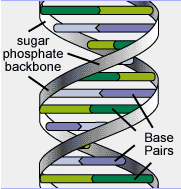
Nucleic
acids are the genetic material of all organisms. There are two types of nucleic
acid, deoxyribonucleic acid and ribonucleic acid (RNA). The genetic material for
most organisms is DNA whilst RNA is involved in protein synthesis and is the
genetic material of some viruses. When the cell is not dividing, the DNA is
packed into a mass of chromatin in the nucleus. This changes during cell
division with the DNA becoming more tightly packed and condensing into
chromosomes.
Nucleic
acids consists of a nitrogenous base, a five-carbon sugar and a phosphate group.
The bases are pyrimidines and purines which differ in chemical structure.
Pyrimidines include cytosine (C), thymine (T) and uracil (U) and are six-membered
rings. Purines include adenine (A) and guanine (G) and are fused five- and six-membered
rings.

C,
A and G are found in both DNA and RNA, whereas T is found only in DNA and U is
specific to RNA. A nitrogenous base bound to a five-carbon sugar is known as a
nucleoside. The sugar involved is either deoxyribose or ribose, corresponding to
DNA and RNA respectively. With the addition of a phosphate group, this becomes a
nucleotide and nucleic acids are formed by chemically linked sequences of these
nucleotides.

The
structure of DNA is a double helix whose backbone is composed of sugars bound to
phosphates. The distance between the chains is constant. The bases face inward
with a purine always binding to a pyrimidine. In this way, the helix bases are
complementarily paired through hydrogen bonds - A bonds only with T, C only with
G.


The
arrangement of nucleotides and bases provides the hereditary information of DNA
i.e. the genetic code. Three successive nucleotides and their bases make up a
codon, which is the signal for an amino acid. A series of amino acids make up a
polypeptide chain or protein. As many amino acids have more than one codon, the
code is said to be degenerate. Three codons are termination signals and one is
an initiation signal. For protein synthesis to occur, DNA must initially be
transcribed into RNA.
DNA
replication ![]() RNA
RNA ![]() Protein
Protein
A
gene is a DNA segment involved in producing a polypeptide chain located on a
specific region or genetic loci of chromosomes. It includes non-coding regions
before and after the coding loci and intervening sequences called introns
between individual coding segments called exons. Genes may exist in alternate
forms called alleles with no more than two alleles for one gene. Nucleotide
changes or mutations may occur in the gene that result in minor effects or
pathological consequences. A gene may exist in multiple alleles within a
population which is referred to as genetic polymorphism. This is the molecular
basis of forensic DNA typing.
It
has been revealed that much of the genome consists of nucleotide sequences
occuring outside of genes, which are similar to introns in the respect that they
have a non-coding function. Their exact purpose is not well understood but most
differences in the human genome occur within these regions. These genetic
polymorphisms are unique between individuals. The nucleotide sequences occur as
variable numbers of tandem repeats (VNTR). Each sequence is approximately twenty
to forty base pairs in length and is repeated a different number of times in
each individual. The identification of these areas creates the DNA fingerprint
of a particular individual.
Genetic polymorphism has been used in the field of forensic science for many years.